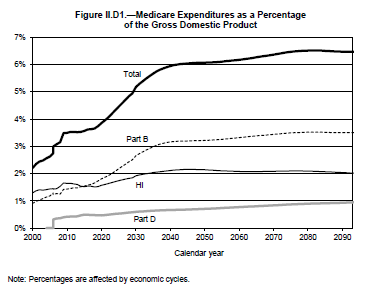On April 22, 2020, the Medicare trustees released their annual report on the status of the two separate trust funds, the Hospital Insurance (HI) Trust Fund and the Supplementary Insurance (SMI) Trust Fund. The Board reports annually on the financial operation and actuarial status of the program in a combined report that covers Medicare Part A, Part B, and the prescription drug benefit (Part D). The HI Fund consists of Medicare Part A and helps to fund inpatient hospital services, hospice care, and services provided by skilled nursing facilities and home health agencies following a hospital stay. The SMI Fund includes Medicare Part B and Part D. Projections in the report are generally based on current law.
The two trust funds are financed very differently. The HI Trust fund is subject to more variation since employee and employer tax rates do not change to meet expenditures of the fund, unless altered by legislation. However, under current law, Part B and Part D premiums are determined annually and general revenue financing covers expected cost, leading to a better financial standing for the SMI fund.
This annual report does not reflect the potential impact of the ongoing COVID-19 pandemic on the Medicare program. The Trustees note that they believe it is not possible to adjust the estimate accurately to reflect the pandemic at this time but do acknowledge that the pandemic is expected to affect the economic, health care, and demographic assumptions used for the projections on the hospital fund. The report says “it is conceivable that actual program experience could be worse than projected in the high-cost scenario, particularly in the near term.”
Medicare costs are expected to steadily increase as a percent of GDP over the next few decades, rising from 3.7 percent of GDP in 2019 to 6.0 percent in 2024. Projections indicate that HI tax income and other dedicated revenues will fall short of HI expenditures in future years.
Hospital Trust Fund Depletion Date Remains at 2026
The Medicare Trustees are still predicting that the HI trust fund will be depleted in 2026, which is the same as the prediction in last year’s report. The HI fund continues to not meet short-range financial adequacy tests, meaning the Trustees determined that the fund is not adequately financed over the next ten years. The fund has not met the Trustees’ test of short-range financial adequacy since 2003. The HI trust fund also did not meet the Trustees’ long-range test.
Conversely, the SMI trust fund is expected to be adequately financed over the next 10 years and beyond. The Trustees attribute this to income from premium and general revenue for Medicare Part B and Part D. However, short-range results indicate that Part B and Part D costs have grown faster compared to the growth of GDP and will continue to do so. The long-range outlay results from Medicare Part D are slightly lower in this year’s report because of slower overall drug price increases and higher direct and indirect remuneration.
For the fourth consecutive year, the Trustees are issuing a determination of projected excess general revenue Medicare funding because the difference in outlays and dedicated financing sources is projected to exceed 45 percent of outlays within 7 years. Since this determination was made in the last year’s report as well, a Medicare funding warning is triggered, which requires the President will have to submit to Congress proposed legislation responding to this warning within 15 days of the submission of the Fiscal Year 2021 Budget. Congress will then have to consider the legislation on an expedited basis.



